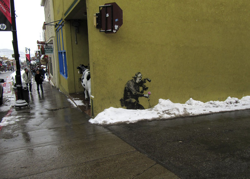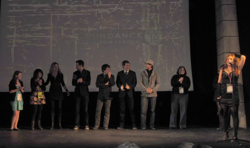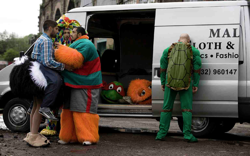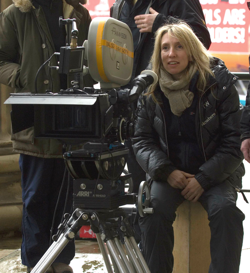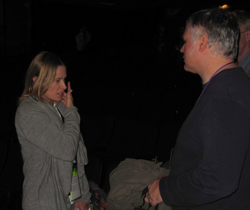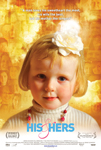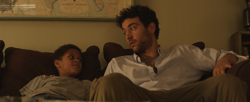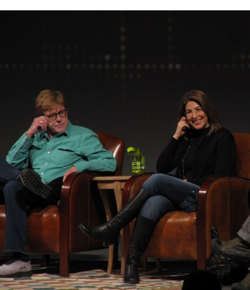Attendance was reported to be down a little at this year’s Sundance. It seemed that way but since we attended for the second half only it wasn’t perfectly clear. There were still sold out movies but in general the lines seemed a little shorter. This is still an industry festival and so it’s a great place to take the pulse of the industry. The pulse is a little weak. One of the great things about Sundance is that directors, cast and crew are usually in attendance and available for Q&A after their film plays. A common question is ‘What is next for all of you’ and this year more than in the past the common answer was ‘I don’t know, do you know where I can find work?’ A more scientific measure is to see how many films were being bought by distributors. You’ll usually hear plenty about this just from talking with people in line, especially if a bidding war has broken out. We didn’t hear much of that this year. What we did hear about was a Sundance film paying for its own distribution. I think the film in question was Splice which we did not see. If you’ve got enough money to make a big budget movie you probably have enough to pay for one of these ‘service deals’. What’s going to happen if this becomes the standard way of doing business? Seems like it would lead to only big budget movies in theaters. Seems like we already have that. Maybe it will lead to a merger between movie studios and movie theaters. Can’t wait.
The graffiti artist Bansky was a special guest in the town of Park City (Park Town?). He was there in support of the documentary film Exit Through The Gift Shop which documents the attempts on the part of the film maker to track down the elusive artist. (Note to self, make a documentary about Scarlett Johansson) We didn’t get to see the film but found a couple of Bansky works around town, this one was easy to spot, right off Main Street.
(Sundance photos by Ray Keller)
On the technical front the interesting thing was that we saw only one movie that was not in 16×9 format. Questions about cinematography are pretty common at Sundance Q&A’s and this year a common answer was that the film was shot ‘in the Red’ or ‘on the Red’. Meaning it was shot with the Red One camera (http://www.red.com) a popular digital camera capable of 4k resolution at 16×9 (4096×2304).
There are always lots of short films at festivals, they are often paired with similar features and are also shown together in groups. The short film Last Address, a video compilation of the addresses of prominent New York Artists who have died from Aids, was paired with Basquiat, this weary moviegoer had forgotten that there was to be a short before the feature and thought for a while that he was watching the main attraction.
I’ve usually not commented on the shorts since I figured there was not too much chance of people tracking them down. Youtube and itunes have changed all that so I want to mention some of the exceptional shorts we saw.
Short: Little Miss Eyeflap
A modern retelling of Little Red Riding Hood, set in Norway, Ms Hood is played by writer/director Iram Hag, a woman of Pakistani origin. No surprise that the theme of the fairy tale, about the pressures on young women coming of age, has cross cultural appeal but there are some distinctly modern touches in this telling. Aided by ingenious use of CGI. Avatar may be heralding a new age in the possibilities of super-budget CGI effects, this little film is also setting the bar higher, for films of any budget.
Short: Glottal Opera
An orthoscopic (rhinoscopic?) camera is inserted through the nasal passages of a quartet of female singers while they sing. I was prepared to tell you how if it were on YouTube you would probably pass it on to your friends… well it is on YouTube..
http://www.youtube.com/watch?v=xa1K_ia21NA
Short: Drunk History
People get drunk and discuss historical events. Famous actors act out what they say. We were fortunate to see Don Cheadle as Frederick Douglas to Will Ferrel’s Abraham Lincoln. I suspect this will eventually be on YouTube, there are some other Drunk Histories on there already, search on ‘Drunk History’ in YouTube. These are also being included in the new HBO comedy series Funny or Die Presents.
Grown Up Movie Star
The short Little Miss Eyeflap was paired with this film that also deals with the pressure on young women. This film is set in Newfoundland and most of the cast is from there. After seeing the terrific film Victoria Day at last year’s Sundance and now Grown Up Movie Star I’m starting to build a prejudice that Canadian films are especially adept at realistic portrayals of teenagers and their parents. Another low budget wonder, this film was shot in 21 days in February in Newfoundland. The crew had to deal 75 MPH winds which reportedly would come up out of nowhere. While Victoria Day dealt with the relatively stable lives of teenagers growing up in a suburban setting, Grown Up Movie Star gives an equally realistic portrayal of two sisters, Ruby and Rose, ages 16 and 11, growing up in a very broken home, with too many skeletons in the closet. There are many heart wrenching scenes to be sure and this amazing cast finds the humanity in each of the characters.
Obselidia
This is the perfect film for Sundance. This festival seems to devote about half of its screens to environmental documentaries each year. Obselidia is an environmental drama, or romance to be more precise. The genesis of the film was when writer/director Diane Bell saw her local library giving away complete Encyclopedia Britannica sets. George, the male lead in the film is writing an encyclopedia of obsolete items. Sophie, a projectionist for a silent movie theater believes that love is what animates the world, therefore nothing need be obsolete. The film uses many beautiful ‘found objects’ that the director collected as she was writing the film and unfortunately some ‘found actors’ who’s delivery left much to be desired. The film also generalizes to a discussion about what seems to be the impending obsolescence of our dear planet. While this is a natural direction for the movie to go in it would not strictly be necessary as the original premise has a lot to offer. Unfortunately, to cover the environmental angle the dialogue becomes quite stilted at times as environmental facts and predictions are recited by the actors. Nonetheless, this is a discussion we all need to be having and it’s good to see a film highlighting this fact. In the end the plot veers back to a human story in a very poetic way and the films past sins are quickly forgiven or even forgotten.
Four Lions
A terrorism comedy?? You betcha! Director Christopher Morris is famous in Britain for his send up of local news shows in the series ‘The Day Today’ so he does seem well suited to take on this extremely touchy subject. He got the idea for the film when he read a news account of some Yemini terrorists who had amassed a sizable amount of explosives and set out by boat to deliver them to their intended target, and the boat sank. Terrorism may be something to be feared but the terrorists may well just be a pack of idiots. Of course the police or whatever counter-terrorist organization you might like to name have their moments too and they are portrayed justly. What is so amazing about the film is that it never degrades into a simple Keystone Cops scenario even though some of what transpires is about on that level. The film manages to make it all real and make the audience feel tragedy along with the comedy. The British accents of some of the Pakistani immigrants can be hard to follow sometimes but I found I was able to understand more than 90% of what was going on. When I got lost it was probably more to do with a current British cultural reference than understanding the words themselves. Highly Recommended.
Space Tourist
As we sat down to watch this I was thinking how remarkable it was to be seeing a documentary at Sundance that wasn’t focused on the environment. About twenty minutes into Space Tourist I was relieved of this delusion. This excellent though rather lengthy doc spends as much time on the ground as it does in space. The space part covers the adventures of the first woman to make the journey to the International Space Startion, Anousheh Ansari. It was probably good fortune on the part of the film maker that the person in line to take this trip ahead of Ansari was dropped from the program. Official news reports state that Japanese businessman Daisuke Enomoto was dropped for health reasons but the fact that he was intent on making the journey into space while wearing a costume of his favorite anime character, Char Aznable, may have had something to do with it as well. As it is the film makes no mention of Enomoto but still manages to clearly show us the contrast between those fortunate enough to afford the $20 Million ticket and those who have found work on the ground, cleaning up after the rocket launches. The footage of the cleanup on the Russian Steppe had to be procured with the help of one of those on the crew. Similarly, footage of the training program that the space tourists undergo was obtained by providing a better camera and training in documentary filming techniques to the person tasked with filming the training for insurance reasons. Almost all of the footage, on the ground or in space is fascinating and of course, historic. The Space Tourist program was forefront in our minds when it started but of course it is no longer front page news, there could be no better way to catch up than this documentary.
Nowhere Boy
The Beatles made history, this film gives us a part of the history that I didn’t know. The childhood of John Lennon and the original formation of the Quarrymen. That is probably enough to get millions of people to see this movie and that’s the way it should be. It is thoroughly researched, has contributions from Sir Paul McCartney and Yoko Ono and was lovingly shot in Liverpool and Blackpool. But they will also see a great movie. There is so much to this story that transcends the fact that John Lennon is at the center. He was raised by two women, sisters. The movie is centered on their relationship and how it shaped John. There are great performances all around but especially for the sisters Mimi and Julia, played by Kristen Scott Thomas and Anne-Marie Duff respectively. Ultimately we see John Lennon as the Healer that he was.
I want to make a special mention of a short film, Love You More by the director of Nowhere Boy, Sam Taylor Wood. I was fortunate enough to see this short at two film festivals last year and it kills me that I have no way to recommend this to a wider audience, it is not on YouTube (and would be too risqué there anyway), nor is it on itunes. If the movie gods are smiling it will become an extra on the eventual DVD release of Nowhere Boy. Love You More is also musically based as two teenagers bond over the new single by the Buzzcocks. Oh to be a teenager in London in 77.
Jean-Michel Basquiat: The Radiant Child
Director Tamra Davis befriended Basquiat when she worked in an art gallery in the 1980’s. They shared an obsession with film and she began this documentary then, conducting an interview with the artist which she then kept in storage for 20 years. The film covers the art history exceptionally well and provides a generous look at the expansive work of Basquiat. It also does a great job of capturing the events and flavor of the 1980’s New York art scene. It was of course the scene that Basquiat so much wanted to be part of and the scene that ultimately let him down. As the film shows this artist’s work was steeped in art history and as great art does, pushed the envelope in new directions and challenged the viewers. So the same scene that welcomed what was clearly a monumental talent could not make the final leap into full acceptance. Maybe this was racism, maybe it was the challenging nature of the work itself. Whatever the cause it was part of what kept Basquiat in a state of distrust. Distrust that has lingered on in his family. When the director approached the Mr. Basquiat’s father he stated that he trusted her because he had never heard of her. You might recall the feature film Basquiat directed by fellow artist Julian Schnabel. The family would not grant the rights to use actual Jean-Michel Basquiat artwork so Schnabel had to paint recreations himself. Schnabel’s film is well worth seeing if you haven’t already, it goes more into the story of the artist’s relationship with his mother which certainly was a huge factor in his life. But if you see only one film about this artist who left us too soon, make it this documentary.
That’s me talking to director Tamra Davis…
New Low
An updaed Woody Allen movie set in Gainesville, Florida. A little grungier than Woody Allen perhaps and probably the funniest movie we saw at this year’s festival. Director Adam Bowers (member of the Upright Citizen’s Brigade comedy troupe) got the idea for the film while in college when he met a girl who spent much of her time volunteering for various organizations. He realized she was a much better person than the girls he had been dating and he wondered what that said about him. Made with borrowed equipment and a cast of friends and fellow students, it has a genuine low budget look which is entirely right for this film. See this one when you need a laugh, it’s fantastic.
The Kids Are Alright
This is the third movie in a series about creativity and the role of emotions and boundaries in creativity from writer and director Lisa Cholodenko. That is not obvious to the casual moviegoer I suspect. The first two in the series were High Art and then Laurel Canyon. To get the very most out of The Kids Are Alright one should see the other two first. This is because there are some direct references to the previous films but mostly because it’s a continuation on the theme or. a continued evolution of a psyche as it works through these issues. I’ll expand on that in a minute here. First, The Kids Are Alright will have absolutely no trouble standing on its own. In fact the star power is enough to make this a compelling film. Annette Bening and Julianne Moore play the lesbian mothers of two teenage children, Mark Ruffalo plays the anonymous sperm donor for both of the children. Bening’s performance especially is well worth the price of admission. The younger, male child desires a connection with his father so when the older sister reaches 18 they take advantage of their right to contact him. That is quite enough to make for a good film but there is so much more going on here when the film is seen along with its mythological roots. I feel like I could write a book about these films and maybe I will, for now I will just get right to it.
The Kids Are Alright and its predecessors all deal with the same question: How do you balance the creative impulse with business? Or on an internal level, how do we obtain a functional and satisfying boundary between the chaotic world of emotion and the need to function in the real world? In High Art we see a first attempt at establishing such a boundary after a prolonged absence. In this instance the creative impulse is played by Ally Sheedy, the emotions by Patricia Clarkson, the organizing function of drive and ego by Rhada Mitchell. When water (emotion) leaks from Sheedy’s apartment down to Mitchell’s a new connection is made and a process of change is initiated. These various psychic parts will have to find a new equilibrium. The end of High Art leaves us with an unhappy (non functioning) resolution to the problem.
But since nothing dies in the psyche the story picks up again in Laurel Canyon with new characters in a new setting but representing the same issues. This time some lessons have been learned so there are clearer boundaries though they are still challenged. When these kinds of internal boundaries are first formed they must be rigid to work, they require conscious attention. Also, though these rigid boundaries have helped to lift this version of the psyche to a more functional level, the integration is not complete as the ‘drive’ function/character is kept at a distance (record executive ‘Claudia’ communicates only by phone with the creative impulse – record producer ‘Jane’ played by Frances McDormand). Similarly, the organizing function as played by Christian Bale as Jane’s son has been away, views his mother with some degree of contempt and doesn’t feel at home at her house. The lesson in this case is that a firm boundary is required for these parts to live in the same house (psyche) but at the same time the organizing principal will have to accept the chaotic nature of emotions. The ending shows a bemused Christian Bale sinking into the swimming pool at his mother’s house while his mother’s much younger boyfriend navigates across the pool using a toy boat tied to his toe for propulsion.
In The Kids Are Alright the organization/drive (Annette Bening) and chaotic feeling (Julianne Moore) are finally able to live happily together, each having given birth to a child with the help of an anonymous sperm donor (the creative impulse, in this case played by Mark Ruffalo). When that creative impulse is brought back into the fold by those very children, boundaries are again tested and the psychic house is in jeopardy.
There are other clues within each of these films that tell us that they are connected. My favorite is the allusion to Russian novels, those that gave rise to existentialism (which deals with emotions, actions, responsibilities). The opening and ending scenes of High Art include a receptionist with her nose buried in a novel by Dostoyevsky. In The Kids Are Alright, when Julianne Moore’s character is at her most distressed, confronted by her family over her misdeeds, she exclaims that maybe part of her problem is that she didn’t read enough Russian novels.
Many films or stories can be viewed through this mythological lens though I know it is far from being the norm. When High Art came out I was seeing it for something like the fourth or fifth time when I saw a woman with too much time on her hands telling the concessions stand attendant and anyone who would listen that she couldn’t imagine why anyone would like High Art, a movie about heroin addicted lesbians. The concessions stand attendant was actually trying to tell her that the movie was about much more than that but I couldn’t stay around to listen, the movie was starting.
At these film festivals I go to I’ve had the chance to talk to many people in the film industry, even the Hollywood types, overdressed and Blackberry glued to their left hand, will talk about whether a movie has ‘heart’ or not. The Kids Are Alright has heart. All the Lisa Cholodenko movies I have seen have heart.
Gasland
Winner of the Grand Jury prize in the Documentary category. I have to admit that I was becoming a bit cynical about what it takes to win a slot at this festival, every movie we saw had an environmental component. I’m as sympathetic to the environmental cause as is humanly possible, but still, this is a movie festival, not an environmental festival. After seeing Gasland I think the festival did not emphasize the environment enough. Using a process developed by Haliburton, oil and gas companies have been busy expanding natural gas production across America. Using a process called ‘Fracking’ as in ‘fracture’ of oil shale formations using water. Now, it takes millions of gallons of water for a typical well and that seems bad enough. But, it turns out that the process can be aided by the addition of chemicals to the water. Up to 600 chemicals might be used. Not baking soda either, try benzene and any and all sorts of derivatives such as tri-chlorobenzene, tri-ethyl glycol, toluene, none of them good. Most of them not even disclosed. These wells are installed in people’s yards. The predictable result is horrible pollution of nearby wells and tap water that can be lit on fire.
The filmmaker got started on this investigation when he was offered $4750 per acre to sign the rights for a Fracking natural gas development for his family land. This land is in the Delaware river basin, part of NY city watershed. Thankfully no Natural Gas wells have yet been started in the area. In 1969 the Cuyahoga River caught fire. The sheer absurdity of this helped to spur an environmental movement that culminated in the passing of the Clean Water Act in 1972. The 2005 Energy Policy Act specifically exempted Oil and Gas companies and the Fracking process from the Clean Water Act and the Safe Drinking Water Act. Everyone in the country saw the Cayahoga River fire on the news, let us hope that enough people see this documentary, and tap water on fire, to spur a change again.
Please Give
This is the new film from one of my favorite directors, Nicole Holofcener. Her previous features are Walking and Talking, Lovely and Amazing and Other People’s Money. All of these films share the same quality as this new one, the most realistic dialog and characters ever seen on film. Catherine Keener is a regular in Ms. Holefcener’s movies, in this one she is joined by Oliver Platt and Amanda Peet. The action is so simple that any attempt at description will not do it justice. Keener and Platt are a NY couple with an aging neighbor, an aging neighbor in NY means that the apartment is a hot commodity. Peet and Rebecca Hall are the granddaughters of the aging neighbor. Death, fairness, acceptance, mothering are all themes of this movie, and it is so well written you will quickly forget that is it a movie at all.
Winter’s Bone
Winner of the Grand Jury Price in the Dramatic category, based on the novel by Daniel Woodrell. A young woman living in the rural Ozarks has a mother that is no longer functioning, two younger siblings to take care of and all sorts of trouble with what amounts to the local mafia. Shot in Missouri with a cast mostly from an MSU acting consortium, many of the faces seen here are not typical Hollywood which is refreshing to see and of course only enhances the authenticity of the story. The only moment in this film where the actors seem to drift off just a bit is on a lingering shot of a cute dog. This was yet another Sundance movie with a female director, Debra Granik. And, this was yet another Sundance prize winner that had not won a distribution deal by the end of the festival. There is a lot of heart in this film and it will stay with you long after you see it.
His & Hers
A treacly documentary of women. Or more precisely, middle class females in the Midlands area of Ireland. This film is firmly in the talking-head camp of documentary film making except for the opening scenes which are in the crawling-baby camp. It’s hard to go wrong with this subject matter, covering female humans from cradle to near-grave but it seems possible to go more-right, to go deeper. Yes there are some touching moments, in fact there’s almost nothing but touching moments but the film left me a little flat. I’m sounding kind of crass here but if you set out to make a movie with women telling their stories, you might seek out the really good stories. Probably I should lighten up, these are their stories, deal with it. Well, I’ll say this, it could be a great date-night movie, maybe one of the best ever. While I remember this film as a talking-heads type doc, it won the World Cinema Prize for Cinematography for some of the other shots, indoors and outdoors in Ireland.
Wasteland
A documentary, winner of the World Cinema Audience Award, this film follows Brazilian artist Vik Muniz as he embarks on a project to create some art with workers from the largest land fill in the world, in Rio Di Janeiro. The art work in the end is beautiful. This is not some assemblage of garbage meant to make you think about garbage at the expense of beauty. The garbage is selected and assembled as large scale portraits and then photographed from above. The film doesn’t actually reveal this till near the end so sorry for the spoiler but it’s evident from the movie poster. The people that Muniz works with are also beautiful and that is point of course. Their stories and individual fates are about as heart wrenching as it gets. These folks are ‘pickers’, they find recyclable materials amongst the piles of garbage and sell them for what they can, every day. Some have been doing it for decades, some have children, some disappear, all have had a hard life. The movie is a bit long and the opening scenes with Muniz discussing the project with his wife and manager look to be recreated, badly. Still, in the end the film sticks with you in a good way. Music by Moby.
happythankyoumoreplease
This film was quite popular with Sundance attendees, winning the Audience Award in the Dramatic category. But it’s not that popular with me. Six young adult New Yorkers with no money and really nice apartments.. where have I heard that before? Ok the plot of happythankyoumoreplease would not fit neatly into a half hour sitcom but I think it would work well as a two part episode. One of the New Yorkers, Sam Wexler (played by writer/director Josh Ridner), finds himself responsible for a young boy abandoned on the subway. Sam tries to do the right thing from there out, sometimes stretching the bounds of believability but hey, it’s a movie. My beef is with the dialogue and acting. When a movie is set in NY and populated (presumably) with NY actors I tend to expect great things and it’s just not here. Too often both the script and performances let you know that you are watching people trying to make a movie. Sometimes the scenery of a NY movie can make it all worthwhile but that is not here either. Perhaps a sign of the times that last year’s Audience (and Jury) Grand Prize winner was Push which was released as Precious, a really hard to watch portrayal of a severely abused black child while this year’s Audience choice was a sort of fantasy rescue of an abandoned black child. Unfortunately this year’s choice is hard to watch as well.
The Shock Doctrine
A documentary based on the book by the same name by Naomi Klein. The premise of the book and movie is that there are certain corporations and individuals in government that are prepared to take advantage of disasters, natural or man-made, for economic gain. So much so that they might be encouraging or exacerbating bad political situations to further their chances. While those sorts of clandestine activities are always difficult to prove outright the film makes an excellent case and makes it interesting with archival footage, not just talking heads. The editing and pacing we can likely credit to co-director Michael Winterbottom (24 Hour Party People). The showing of the film that we attended was followed up with a panel that included Winterbottom, Klein, co-director Mat Whitecross and the man himself Robert Redford. Post-movie Q&A’s are one of the great joys of Sundance and I still haven’t gotten over that we had to leave this one to get to another film.



